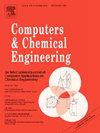A cheminformatics-based methodology to incorporate safety considerations during accelerated process development
IF 3.9
2区 工程技术
Q2 COMPUTER SCIENCE, INTERDISCIPLINARY APPLICATIONS
引用次数: 0
Abstract
The fine chemical industry regularly develops novel products for diverse applications and produces them at scale in multi-purpose, batch processes. These processes often involve highly hazardous chemicals and reactive chemical hazards. If an unacceptable risk is identified after the production route has been finalized, it would necessitate expensive redesigns and result in suboptimal risk management strategies with significant delays in time to market. It is, therefore, desirable to consider inherent safety analysis during route selection. The traditional methods for inherent safety analysis are not directly applicable to the fine chemicals industry which have unique characteristics; specifically, they require information on a large number of properties of materials and reactions, which are not usually available for novel pathways, especially at the route selection stage. While safety data could be determined experimentally, this would be time-consuming and expensive, especially if the route were to be rejected later in the process development. In this paper, we propose a practicable methodology that addresses these important challenges unique to fine chemicals industry. Our methodology leverages chemoinformatic models, which are increasingly becoming available and reliable, to estimate material and reaction properties. Various chemoinformatic models are systematically integrated into the process development workflow so that fire, toxicity, and reactivity hazards can be estimated when necessary, thus enabling inherently safer route selection. The methodology is illustrated using an industrial case study of Boscalid manufacture. Fifty-three safety-critical properties are predicted using various chemoinformatics methods and enable the identification of safety issues at the early stages of the process lifecycle.
一种基于化学信息学的方法,在加速工艺开发过程中纳入安全考虑
精细化工行业经常为各种应用开发新产品,并在多用途批量生产过程中大规模生产。这些过程往往涉及高度危险的化学品和反应性化学品危害。如果在生产路线确定后发现不可接受的风险,则需要进行昂贵的重新设计,并导致次优风险管理策略,从而导致上市时间的显著延迟。因此,在选择路线时考虑固有安全分析是可取的。精细化工行业具有独特的特点,传统的固有安全性分析方法不能直接适用于精细化工行业;具体来说,它们需要关于材料和反应的大量性质的信息,这些信息通常不适用于新途径,特别是在路线选择阶段。虽然安全数据可以通过实验确定,但这将是耗时和昂贵的,特别是如果该路线在工艺开发的后期被拒绝。在本文中,我们提出了一个切实可行的方法,以解决这些重要的挑战,独特的精细化工行业。我们的方法利用越来越可用和可靠的化学信息学模型来估计材料和反应性质。各种化学信息学模型系统地集成到工艺开发工作流程中,以便在必要时可以估计火灾、毒性和反应性危害,从而实现更安全的路线选择。该方法是用一个工业案例研究波斯卡利德制造说明。使用各种化学信息学方法预测了53个安全关键属性,并能够在过程生命周期的早期阶段识别安全问题。
本文章由计算机程序翻译,如有差异,请以英文原文为准。
求助全文
约1分钟内获得全文
求助全文
来源期刊

Computers & Chemical Engineering
工程技术-工程:化工
CiteScore
8.70
自引率
14.00%
发文量
374
审稿时长
70 days
期刊介绍:
Computers & Chemical Engineering is primarily a journal of record for new developments in the application of computing and systems technology to chemical engineering problems.
 求助内容:
求助内容: 应助结果提醒方式:
应助结果提醒方式:


